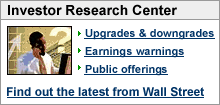| dick tracy | 08-20-2007 | comment profile send pm notify |
|
NEW YORK (CNNMoney.com) -- The Federal Reserve, reacting to concerns about the subprime lending crisis that's rocked financial markets in recent weeks, Friday cut its so-called discount rate half a percentage point, to 5.75 percent. The discount rate, the rate the Federal Reserve charges qualified lenders, mainly banks, for temporary loans, is largely symbolic. The central bank did not change its more closely watched federal funds rate, which affects credit cards, home equity lines of credit, car loans and other consumer loan rates. That rate remains at 5.25 percent. But one economist suggested that the Fed's discount rate cut has more than token significance. David Wyss, chief economist with Standard & Poor's, said the cut could help convince banks it was okay to keep lending to companies or consumers that actually are creditworthy. "This is an important move. It's not just a symbolic action. The Fed is telling banks that the discount window is open. Take what you need," Wyss said. Wall Street cheered the cut. The Dow Jones industrial average surged 300 points at the open and finished the day up about 230 points, or 1.8 percent. The Nasdaq composite closed up 2.2 percent while the S&P 500 gained nearly 2.5 percent. Stock futures were trading lower before the open after another wild day Thursday but surged following the Fed's announcement. "The Fed is trying to maintain some stability in the market. They can't control the financial markets, which are being driven by emotion right now. But this move was a good option that will bring some relief to the market," said Oscar Gonzalez, an economist with John Hancock Financial Services. The Fed last met Aug. 7 and decided to leave both the federal funds and discount rates unchanged. One economist said if the Fed changed course on Friday and cut the federal funds rate, that actually may have spooked Wall Street. "The Fed wanted to ensure liquidity to the markets but they don't want to send a message that they are panicking. It was only a week and a half ago that they said the outlook for the economy was for moderate growth," said Kenneth Kim, an economist with Stone & McCarthy Research Associates, an economic and bond research firm based in Princeton. "To suddenly turn around and cut the fed funds rate would have made them look foolish." Nonetheless, stocks have plunged further since the Fed's last meeting due to fears that some financial institutions and hedge funds were in serious trouble because of the mortgage meltdown. Mortgage lender Countrywide Financial (Charts, Fortune 500), for example, announced Thursday that it needed to tap an $11.5 billion line of credit because of liquidity problems. That came a day after an analyst at Merrill Lynch suggested that Countrywide might need to declare bankruptcy. "The credit crunch is both real and driven by fear but primarily fear. Nobody knows who is exposed to these subprime loans. Uncertainty is the problem," said Zach Pandl, an economist with Lehman Brothers. With this in mind, several market observers felt that Fed chairman Ben Bernanke needed to acknowledge the risk that the subprime mortgage crisis could hurt the broader economy. In a statement, the Fed said it took the move to "promote the restoration of orderly conditions in financial markets." In another statement, the central bank indicated that "financial market conditions have deteriorated, and tighter credit conditions and increased uncertainty have the potential to restrain economic growth going forward." The Fed added that "although recent data suggest that the economy has continued to expand at a moderate pace, the Federal Open Market Committee judges that the downside risks to growth have increased appreciably" and that the Fed was prepared to take more action if necessary. The Fed, as well as other central banks around the world, had responded to the market turmoil by pumping more cash in to the banking system over the past week. But many market observers felt the Fed would also need to lower rates to restore investor confidence, citing the example of former Fed chair Alan Greenspan. Under Greenspan's stewardship, the Fed cut the federal funds rate at an emergency meeting in 1998 as a result of the Asian financial crisis and also lowered rates at two unplanned meetings in early 2001 due to an economic slump and again that year after the Sept. 11 terrorist attacks. While Greenspan was praised at the time for these rate cuts, some have since criticized him for helping to create a low interest-rate environment that fostered a culture of "easy money" where consumers who had poor credit histories were able to take out the types of exotic mortgage loans that are now defaulting. One money manager said the Fed should not go ahead and cut rates to bail out consumers who took out loans they never should have - and the banks that made the loans and hedge funds that invested in them. "The Fed is putting its fingers in the cracks of the dike," said Matthew Smith, president and chief investment officer of Smith Affiliated Capital, an investment advisory firm based in New York. "There is nothing the Fed can do. They are just prolonging the inevitable. The Fed has to get the speculators out of the market." Wyss did not buy this argument though. "If you enjoy cutting off your nose every time you have a cold, then not cutting rates would be a good strategy .There a lot of people who have this puritanical view that everyone should be punished," he quipped. "But the Fed's job is to worry about the whole economy. It has to make sure that rest of the economy doesn't suffer. What the Fed did today has nothing to do with bailing out banks. If (banks) were going to lose money on a bad mortgage (they) will still lose money." With that in mind, the central bank's next scheduled meeting is Sept. 18. According to federal funds futures listed on the Chicago Board of Trade, investors are betting that it is all but certain the Fed will cut the federal funds rate by at least a quarter of a percentage point. Lehman's Pandl expects a quarter-point rate cut in September and another one after the Fed's two-day meeting in late October. That would bring the fed funds rate down to 4.75 percent. But Pandl does not think the Fed will need to act before September since Friday's move may be enough to reassure Wall Street that it has things under control. "This is a good sign that the Fed is addressing the problems in the market. This buys them a little time. It's the appropriate action," he said. Smith, however, thinks a rate cut would be a mistake since it's far from clear that inflation won't later become a problem. "The Fed is in a bind. Weakening the dollar could boost inflation," Smith said. "The problem is if the Fed cuts rates it could put the dollar into a bigger tailspin. Oil prices would go up. Gold prices would go up." And even more worrisome, Smith said, is that U.S. Treasury bonds could become less attractive to foreign central banks if the dollar falls further. If global investors stop buying Treasuries, or dump bonds they already own, that could drive long-term rates higher since bond yields rise when bond prices fall. |
||
| dick tracy | 08-20-2007 | reply profile send pm notify |
Analysis: Fed rate cut encourages marketWASHINGTON --A dramatic cut in the Federal Reserve's discount rate sent stocks soaring Friday, but the spreading global credit crisis means the Fed will almost certainly have to do more. A cut in the more important federal funds rate is expected to follow in short order as the central bank battles to keep the economy out of recession. Some economists believe the Fed could engineer more interest rate reductions at each of its three remaining meetings this year. With his surprise announcement before Wall Street opened for trading on Friday, Federal Reserve Chairman Ben Bernanke, a former Princeton professor, went from being a "C" student in the eyes of investors to earning an "A-plus." The Dow Jones industrial average shot up more than 300 points right after the opening bell and held on to most of the gains to finish the day up 233.08 at 13,079.08. Bernanke found a clever way to give banks access to badly needed funds by cutting the discount by a half-point to 5.75 percent. That is the interest rate the Fed charges banks for direct loans. The Fed's action was seen as a way to prod banks to step up their short-term lending in the face of a near paralysis in many debt markets. The current credit crisis began with rising defaults on subprime mortgages, loans made to borrowers with weak credit. It marked the Fed's first change in rates between regularly scheduled meetings since Sept. 17, 2001, when the central bank was struggling to get financial markets back into operation after the terrorist attacks on the World Trade Center. Even more important than what the Fed did on Friday was what it said. In a brief statement, Bernanke and his colleagues on the Federal Open Market Committee said they judged that "the downside risks to growth have increased appreciably" and they were "prepared to act as needed to mitigate the adverse effects on the economy arising from disruptions in financial markets." That statement was seen as a clear signal that the Fed had moved its "bias" -- which signals the next direction for interest rates -- from seeing inflation as the biggest economic threat to concern about weak growth. Fed worries about inflation mean possible interest rate hikes, while worries about growth mean possible rate cuts. The new wording marked a significant shift from just 10 days ago. At the Fed's last meeting on Aug. 7, it held interest rates unchanged and repeated the view that it still believed the predominant risk to the economy was that inflation would not slow as expected. That statement produced dismay in financial markets as investors worried that Bernanke, the academic, was proving less adept than his predecessor, Alan Greenspan, at responding quickly to the first signs of market distress. Greenspan began building his legend with his quick response to the Black Monday stock market meltdown in October 1987, which occurred just two months after he took over as Fed chairman. Greenspan moved to insulate the economy from that severe episode of stock market turbulence. Bernanke's actions since Aug. 7 have helped him rebound from what was seen as an initial stumble. Since last Thursday, the Fed has pumped billions of dollars into the banking system in daily infusions to make sure banks have sufficient reserves to respond to borrowing demands from creditors who found their normal sources of money drying up. Then with Friday's cut in the discount rate and the statement signaling the Fed was contemplating cuts in the funds rate, the impression of Bernanke's crisis-management skills improved further. "The Fed was behind the curve in dealing with this crisis before today. Now they are even with the curve," said David Jones, chief economist at DMJ Advisers, an economic consulting firm. "They now have a better chance of mitigating the damage from an all-out global credit crisis." The thinking now is that the current credit crisis could establish Bernanke's reputation just as Black Monday did for Greenspan two decades ago. But a lot will depend on whether the Fed will act forcefully enough to instill confidence and keep the economy out of a recession. "There was a lot of fear and panic out there. Investors were looking for someone to lead and that is what the Fed did today," said Lyle Gramley, a former Fed board member and now senior economic adviser at Schwab Washington Research Group. But Gramley said he still put the possibility of a recession at about 50-50 as the credit crisis adds to earlier problems stemming from a serious slump in housing that has dragged down consumer confidence. One worrisome sign on that front was the report Friday that the University of Michigan's consumer confidence survey for early August fell from 90.4 in July to 83.3 in early August, the lowest point in a year, a drop blamed in part on the recent market turmoil. If people grow more concerned, they could cut back on their spending, which would be a serious jolt since consumer spending accounts for two-thirds of economic activity. Friday's move to cut the discount rate will not have an impact on consumer interest rates in the way that cutting the federal funds rate triggers an immediate drop in banks' prime lending rate, the benchmark for millions of consumer and business loans. However, Friday's move will allow banks to deal with the severe credit crunch by making it easier for them to make loans to businesses. With the housing market sinking deeper into gloom and credit to businesses drying up, analysts have been slashing their forecasts for growth, as measured by the gross domestic product, for the second half of this year. Mark Zandi, chief economist at "While Bernanke started out the class weakly, he is catching up fast," Zandi said. "The final exam hasn't been taken yet, but at the moment, it looks like he will do well." ------ EDITOR'S NOTE -- Martin Crutsinger has covered the economy for the AP in Washington since 1984. ------ |
||

_1.png)





















.jpg)
.gif)

.jpg)









.jpg)








